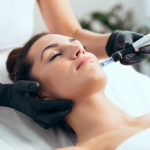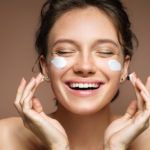Photo by ShotPrime Studio by Shutterstock
Attributing acne to oily foods or inadequate hygiene has, thankfully, become very rare. People now understand that acne has many causes and consult dermatologists for assistance. Seeking medical help is much safer and more effective than diet fads or fancy cleansers.
Chloracne is a medical disorder caused by exposure to halogenated aromatic hydrocarbons, which are chemicals containing benzene rings and halogen atoms. TCDD, or dioxin, is one of the most common halogenated aromatic hydrocarbons. Chloracne is a rare type of acne not often seen in Southlake, TX, but exposure to causative chemicals is possible.
Although chloracne isn’t common anywhere in the United States, halogenated aromatic hydrocarbons are present in many types of chemical preparations. Health and safety regulations and laws protecting the environment minimize exposure to harmful chemicals, but these precautions aren’t foolproof. Chloracne does occur in the United States.
Causes of Chloracne
Most cases of chloracne occur after occupational exposure to halogenated aromatic hydrocarbons, such as machine oils containing dioxin. Accidental environmental exposure is possible too. Direct skin exposure is the most common cause of chloracne, although some cases result from chemical inhalation.
Halogenated aromatic hydrocarbons are found in a variety of chemical preparations including:
- Fungicides
- Herbicides
- Insecticides
- Wood preservatives
- Lubricating and industrial oils
Chloracne is associated with TCDD, or dioxin, found in a very potent herbicide commonly known as Agent Orange. Agent Orange was used during the Vietnam war, but it was also used as an herbicide before the dangers of toxicity were fully understood. Residents of Southlake, TX, aren’t in danger of current exposure to Agent Orange, but some veterans and people that lived in other parts of the world were exposed earlier in their lives.
Mild exposure usually results in short-term chloracne, but more severe or extended exposure can cause recurrent skin lesions and scars. Consult your dermatologist if you suspect previous exposure to dioxin may be related to a current skin condition. Even if dioxin is not the cause, your doctor can help you find a solution to skin care issues.
Symptoms of Chloracne and Dioxin Intoxication
Hamartomas
The exact scientific term for chloracne is Metabolising Acquired Dioxin Induced Skin Hamartomas, or MADISH. Hamartomas are localized benign tumors related to genetic changes. Dermatologists identify many hamartomas through imaging studies and other diagnostic tests performed for other reasons.
Most hamartomas grow slowly and remain localized. Hamartomas are usually not dangerous, but they can become malignant in some cases and the causative underlying condition may cause other health problems.
Skin Lesions
Chloracne resembles other types of acne, but there are several differences. Open and closed comedones, commonly known as whiteheads and blackheads, are the most recognizable features. Nodules and cysts form across the cheeks, behind the ears, under the armpits, and in the groin area. The arms and legs are affected in severe cases.
Skin lesions can easily be mistaken for more common types of acne, but skin feels at least slightly oily in most acne cases. Dioxin toxicity changes gene expression of sebaceous glands. Skin may feel very oily during the early stages of chloracne, but oil production declines as the disorder progresses. Oil glands may actually shrink.
Other skin changes caused by chloracne include excessive sweating on palms of the hands and soles of the feet, blisters on exposed skin, and increased skin pigmentation and hair growth. Consult your local dermatologist if you notice increased or unusual acne lesions or other skin changes.
Systemic Symptoms
Dioxin poisoning begins with systemic symptoms. Gastrointestinal illness, such as vomiting, nausea, and diarrhea, is an early sign of exposure. Of course, gastrointestinal symptoms are very common and not likely to be associated with dioxin poisoning without good reason.
Progressive symptoms of dioxin toxicity include, pancreatitis, liver dysfunction, and fatigue or sleep disturbances. Neuropathy and encephalopathy result in depression and poor concentration. Exposure to halogenated aromatic hydrocarbons also increases risk of developing type 2 diabetes and hyperlipidaemia, or high levels of fats in the bloodstream. Other long-term health risks include greater incidence of cardiovascular disease, endometriosis, low sperm count, and certain types of cancer.
Skin changes occur as systemic symptoms begin to fade. Some researchers believe skin changes occur as the toxic chemicals are flushed out of other organ systems and into sebaceous glands.
Diagnosis
Dermatologists and other physicians diagnose chloracne through patient history and clinical experience. Blood tests to measure levels of halogenated aromatic hydrocarbons aren’t reliable. Chemicals are redistributed throughout and the body and metabolized after exposure. Most people don’t associate symptoms of chloracne with chemical exposure in time to rely on blood tests. Sometimes people don’t even realize they’ve been exposed to such chemicals.
The diagnosis is mostly on the grounds of history and expert clinical opinion. A dermatologist may perform a biopsy of affected skin areas. Possible indicators of chloracne include reduced sebaceous gland density and presence of skin hamartomas. An immunohistochemical test, such as CYP1A1, helps doctors identify gene regulation changes in sebaceous glands.
Treatment
After identifying chloracne, the source of contamination must be identified as well. Symptomatic treatment begins after the source is removed. A dermatologist may excise or cauterize large comedones and cysts. Antibiotics treat or prevent secondary infections.
It is very important to consult a dermatologist for suspected cases of chloracne because the disorder isn’t predictable. All symptoms may disappear within a year or two, but some cases of chloracne are resistant to treatment. Follow up is essential. Aromatic hydrocarbons may be carcinogenic. Research is ongoing and carcinogenic effects haven’t been verified or dismissed, so long-term monitoring is the safest course of action.
The knowledgeable and emphatic professionals at Compassion Dermatology will gladly help you with any skin care needs. Call 817-380-5911 at the first sign of any concerning changes in your skin. You can also set up an appointment with a dermatologist for a wellness check.


